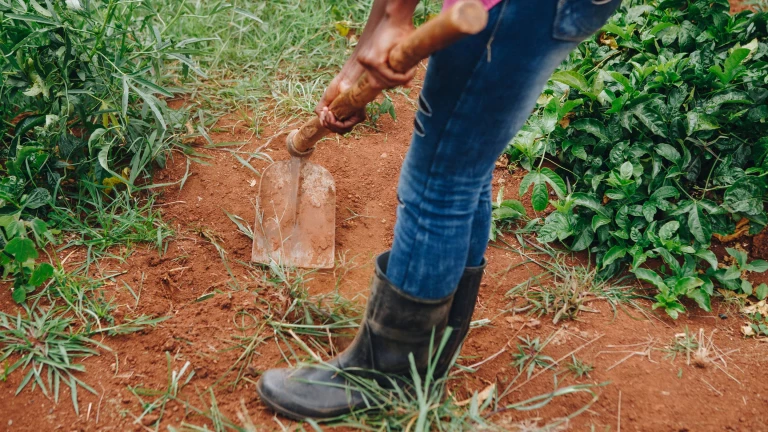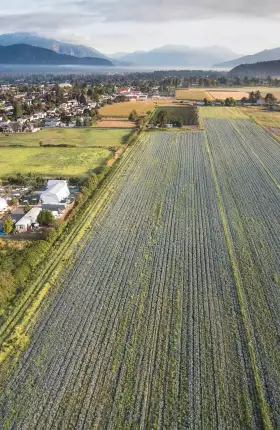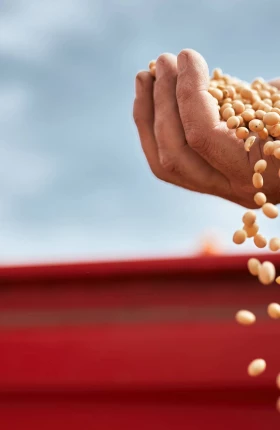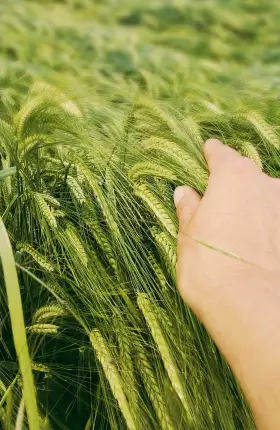It’s a crisis that simply cannot be allowed to go to waste. Africa’s long-standing food crisis, worsened by the COVID-19 pandemic and, increasingly, by
climate change
, threatens to have dire consequences. Up to 650 million Africans—50% of the continent’s population—lack economic or physical access to sufficient food to meet their minimum needs every day. Famine and hunger aren’t unknown in emerging markets, especially in extreme situations such as pandemics, but unless Africa’s food system is transformed, the countries on the continent will never be able to boost agricultural output and economic growth in a sustainable fashion.
Even before the food crisis worsened, all the data suggested that a radical rethinking of food policies in Africa was overdue. During the past two decades, multilateral and bilateral donors have invested billions of dollars—together with advice on best practices and supplies of seeds and fertilizers—in agricultural development on the continent. Their objective is to increase the output of Africa’s subsistence farmers and enable them to feed their families. Yet these farmers’ incomes have barely risen, and many smallholders still live at or below the poverty line. Yields haven’t improved either. In Tanzania, for instance, despite donor investments totaling about $4 billion between 1998 and 2018, cereal yields over the same period have actually declined by 16%. The primary cause of hunger in Africa is rural poverty, not food shortages, and without a radical transformation of the food system, poor Africans will never be able to afford more food. Meanwhile, Africa’s urban population and urban incomes are growing, boosting demand in the cities. But as Africans become richer, the incidence of diet-related diseases, such as diabetes and hypertension, is increasing, too. (See Exhibit 1.)
Although several African governments have taken short-term measures to contain the current food crisis, those policies could increase the agriculture sector’s vulnerabilities in the medium term. Agriculture accounts for a quarter of the continent’s GDP, and in sub-Saharan Africa it provides work for almost 60% of the population, so something has to give in Africa’s food economy—and soon—if the continent is to bounce back to health.
Shifting the Transformation Focus from Supply to Demand
Our focus today will determine the future. For too long, most policy interventions in Africa have targeted the supply side of the food economy. It’s easy to see why: supply-side measures lead to economic policies, budgetary allocations, and aid flows that have an immediate impact on large numbers of rural people. Besides generating tangible first-order effects such as income growth and poverty alleviation, they help coalesce political support in rural areas.
Targeting supply hasn’t produced satisfactory solutions to many of the varied and interconnected challenges that Africa’s food system faces.
Unfortunately, targeting supply hasn’t produced satisfactory solutions to many of the varied and interconnected challenges that Africa’s food system faces. Too often, such efforts smack of a kind of “if farmers grow it, consumers will buy it” reasoning that doesn’t deliver useful results in the long run. (See the sidebar “The Part Aid Must Play.”) We’ve been studying Africa’s food systems for over a decade, and our studies show that a shift in focus is essential.
The Part Aid Must Play
An institution should offer a grant only in the context of a plan to transition projects to financially sustainable local entities. Although some countries put considerable thought into mapping transitions from grants to programs—which NGOs usually implement—such planning is all too often omitted from program design.
One major problem is that too many decision makers lack sufficient knowledge of the local context. Distance in development is logarithmic: the difference between New York and Nairobi is less than the difference between the capital of an African country and one of the villages for which development funding is intended. Most multilateral agencies have increased the number of Africans on their staff, but too few insist that the executing teams on the ground resemble the Africans they’re trying to help.
The international community needs to hold itself to a high standard, reporting its successes and failures accurately. Monitoring and evaluation are part of every program, but agencies and organizations should redouble their efforts to ensure that the causes of failures are as publicly identified and widely understood as the causes of successes. There are still too many repeat engagements of programs that produced few tangible results in the past. If the aid-driven programs of the past 50 years had worked as hoped, global donors would not need to continue pouring money into Africa.
In fact, Africa’s food supply may face a demand problem, with its current structure incapable of stimulating the crop selection, farm productivity, and infrastructure development necessary to achieve sustainable growth. Agriculture policy would deliver better results in Africa if it started by triggering demand differently, valuing consumers’ nutrition and health as much as it does farmers’ incomes.
Rebuilding food demand and distribution is an indirect process that calls for more-sophisticated policies and tax incentives, different infrastructure, and the involvement of businesses and consumers as well as farmers. It will require additional investments in increasing productivity, enabling policies for the private sector, and creating a suitable distribution infrastructure, such as cold chains, across the continent. Even so, starting with demand is more likely to trigger the end-to-end changes that African agriculture needs if it is to produce the right kinds of food by the right farmers for the right markets in an environmentally sustainable way.
Focusing on demand will result in new roles for the actors in Africa’s food system. The private sector will have a bigger part to play in the future; as the most structurally scalable and sustainable part of the food system, it must grow rapidly to catalyze change. The public sector will have to create the enabling environment for the transformation, investing in agricultural R&D and the infrastructure needed to move goods from farms to consumers and ports. (See the sidebar “The Old Players’ New Roles.”) And different regions and countries must step up their cooperation to ensure that they achieve the right outcomes across the continent.
The Old Players’ New Roles
Each nation’s government and state-owned enterprises must create and execute policies to drive its food system’s transformation. This may not be simple because priorities and metrics differ across ministries. It may be necessary to establish an inter-ministerial coordination platform at the national level to help ministries balance the tradeoffs in their funding and priorities.
At the regional level, encouraging regional cooperation and integration to enhance outcomes is essential. Establishing an effective and meaningful African market will be a major accomplishment.
Business has an outsize role to play, and it must grow quickly to increase its impact. Africa’s most promising food businesses should have priority access to capital, talent, and expertise to accelerate, amplify, and ensure their impact.
It will also be necessary to integrate efforts to generate data and analyses to inform policy, NGO program design, and investment decisions. A dashboard that makes all data and reports available to interested parties would help create a single version of the truth. The Food Systems Dashboard (which tracks diets and nutrition), the Observatory of Economic Complexity (trade data), and FAOSTAT (production numbers) are excellent resources, but they don’t show the interdependencies in the system because they aren’t integrated—yet.
Fortunately, the COVID-19 pandemic is forcing Africa to plan differently for the future, creating an opportunity to experiment with bold change initiatives. Policy innovations can effectively mitigate the negative impact of the current crisis, bolster food security, and transform Africa’s agriculture in the long term.
Understanding the System of Challenges
In planning to transform Africa’s food system, a change in the approach to execution is as necessary as a shift in focus from supply factors to demand triggers. Traditionally, policymakers have tried to improve individual components of the system, on the premise that doing so will automatically enhance the performance of the system as a whole. Now, however, experts are recognizing the need to go beyond seeing farms, agribusinesses that manufacture and distribute food products, and consumers as separate elements. (See Exhibit 2.)
Adopting a systems approach to the food economy—which entails managing several diverse but interconnected elements simultaneously—should lead to more productive solutions. By accounting for systemic effects, policymakers can do a better job of identifying the implications and unintended consequences of various policies, so they can modify those policies, if necessary, more quickly. The food sector doesn’t work in a linear way, so ensuring a sufficient level of output alone can’t address all the economic, social, health, and environmental imbalances in Africa’s food system. Only a systemic approach can adequately address the system’s complex challenges, from rural poverty and water scarcity to rising global temperatures and declining biodiversity.
Ensuring a sufficient level of output alone can’t address all the economic, social, health, and environmental imbalances in Africa’s food system.
As a starting point, using the systems lens to analyze Africa’s food problems reveals the numerous connections between the issues at stake. One approach is to conceive of the food economy as a system consisting of five elements: economics, nutrition, society, environment, and—underlying all of these—policy. When viewed through this lens, Africa’s real problems and opportunities come into sharper focus.
Economics. In many African countries, agriculture accounts for too large a share of national output and too large a share of employment, both of which are classic signs of underdevelopment. For instance, the agriculture sector contributed 25% of Kenya’s GDP and 65% of its exports and employed approximately 60% of its labor force in 2019. Similarly, in neighboring Tanzania, agriculture accounted for almost the same share of GDP while employing 75% of the labor force. Unsurprisingly, GDP per capita was just $1,838 in Kenya and $1,077 in Tanzania in 2019, with both seasonal unemployment and hidden unemployment evident in rural areas.
Compounding the problem, Africa is a major food importer, spending over $47 billion in 2018 to buy food on the world market. From 1998 to 2018, food imports shot up by over 1,000% in Ethiopia and Ghana, by over 300% in Nigeria and Kenya, and by 122% in Tanzania. (See Exhibit 3.) Even as the devaluation of several African currencies, in combination with declining commodity prices, strains countries’ food security, the average Kenyan still spends almost 50% of their income on food, and the average Nigerian almost 56%.
Most African governments underfund their agricultural sector. Between 2000 and 2015, for instance, agriculture in Kenya accounted for only between 3% and 6% of public expenditures, substantially less than the 10% that many governments agreed to dedicate to agriculture under the Comprehensive African Agriculture Development Policy (CAADP). Commercial lending to the agriculture sector accounted for only 4% of banks’ portfolios in Kenya in the same period. As a result, the food sector is often starved of the funds it needs for growth.
Nutrition. Eating the right kinds of food helps people live longer, healthier, higher-quality lives. But Africa faces a dual threat in this regard. On the one hand, malnutrition is rife on the continent, especially among children. For instance, in Uganda, 28.9% of children under five years of age are stunted or wasted because of insufficient intake of nutrients.
Rising incomes have boosted consumption of fast food and highly processed foods and lowered demand for healthier traditional foods and cooking mediums.
On the other hand, Africa faces the challenge of rising obesity, albeit from a low base, as consumers’ eating habits change. Rising incomes have boosted consumption of fast food and highly processed foods and lowered demand for healthier traditional foods and cooking mediums. Across the continent, 18.4% of women and 7.8% of men were obese in 2016 compared to just 14.2% and 5.3% in 2006.
Society. Too many people work on the land in Africa because other kinds of employment opportunities are hard to find. Without a structural economic shift, African countries’ agriculture sector will have to employ tens of millions of people—especially young people (below 25 years of age), who make up most of the population in Nigeria (63%), Kenya (60%), Tanzania (63%), Ghana (56%), and many other countries in the region.
Tackling Africa’s gender gap in agriculture should be another priority. In sub-Saharan Africa, half of all impoverished smallholder farmers are women. If they are economically empowered, their productivity and incomes will rise, and they will find the means to prevent malnutrition in their children.
Environment. Because it is tied to the land, soil, water, sunlight, air, seeds, plants, and living organisms, the food system has an outsize impact on Africa’s environment. From farmers’ choices of what crops to grow and how to cultivate them, to the huge volume of waste in the system and linear (rather than circular) packaging, the African food system must become environmentally sustainable.
If the agriculture sector is green today, it’s for the wrong reasons. Two-thirds of African farmers report that they don’t use inorganic fertilizers, and 84% say that they don’t apply agrochemicals. Only 1% to 3% of the land cultivated by smallholder farmers is irrigated at present, and no more than 10% of households have any form of water control—input constraints that contribute to tiny yields.
Only 1% to 3% of the land cultivated by smallholder farmers is irrigated at present—an input constraint that contributes to tiny yields.
Policy. Underpinning the four elements of Africa’s food system discussed above are national and regional rules and policies governing the main actors in the food system. Currently there is some coordination, but it is inadequate to bring about large-scale change. Africa’s governments must adopt a transformative policy, using a cross-governmental approach that involves the ministries of agriculture, food, industry, trade, health, planning, and education, among others, in every nation. Although coordination might not be easy, Africa’s wise leaders could make it happen in the future.
To do so, they must feel a sense of urgency and respond to it by enacting the right policies to help Africa harness agriculture and food for economic development while avoiding the pitfalls of a drastic rise in hunger. For example, one action that the African Development Bank took in the face of the recent pandemic was to create Feed Africa Response to COVID-19 (FAREC). This initiative assists governments, farmers, and companies in as many as 23 African countries in their efforts to minimize COVID-19-related disruptions to the food system. It has helped subsidize farm inputs, created green corridors for cross-border food movement, and stabilized prices by releasing and replenishing countries’ food reserves. FAREC is a model for the kind of effort that the continent needs to undertake, after the pandemic abates, to kick off a virtuous cycle of food consumption, distribution, product creation, and production in Africa.
Five Steps for Transforming Africa’s Food Systems
To address these challenges systematically from the demand side, Africa’s policymakers must take five steps simultaneously: growing industrial demand for agricultural produce, using food processing companies as change agents, diversifying Africa’s demand for food, creating a global market for grown-in-Africa agricultural products, and crafting demand-led agrarian policies.
Grow industrial demand for agricultural produce. African nations must invest strategically in creating agriculture- and food-related industries, especially downstream, so the nature of demand for food changes. Africa’s verdant and varied primary sector has the potential to support almost any kind of business relating to the production, logistics, handling, storage, processing, packing, and retailing of packaged foods. Growing agribusinesses will help move subsistence and unviable farmers, in particular, to related industrial and service jobs, where they can earn higher incomes, increase their purchasing power, and boost food demand.
To meet the demand for raw materials from the new food processing industries, Africa must increase its output of many kinds of crops. That will require coordination—at the national, regional, and county levels in every country—to identify which agricultural products can be produced, which can’t be, and where production should occur. The goal should be to maximize agricultural output and lower prices, not to create distinctions between smallholder and commercial farmers.
Cultivating staples on small plots keeps small farmers in poverty.
Cultivating staples on small plots keeps small farmers in poverty. The reason is straightforward: if the average farmer owns 2 hectares or less of land, either farm productivity or output prices must be extremely high for the farm to be viable. Land fragmentation and lack of access to water and fertilizers make the prospects for realizing either possibility extremely remote, so prioritizing ever smaller landholders will not help the food system transform. In fact, more than half the people in Africa who suffer from hunger are small farmers.
Because the issue of selling and aggregating land is a sensitive one in socioeconomic terms, policymakers must continuously communicate with stakeholders about the need to make progress in this area. The aim should be to generate a consensus in rural communities about the lack of viability of too-small farms, and the paths that lead away from rural poverty. Both government and development funding should focus on helping small farmers increase their land holdings or consolidate by forming cooperatives. Clearer land titles and land registration will ensure that the legal system can help resolve conflicts fairly and quickly, should the need arise.
There should also be a concerted effort to get farmers to boost yields of existing crops and, over time, shift to cultivating higher-value crops. It won’t be easy. Today, over 60% of fields in Africa are still ploughed by hand, which limits productivity and yields. Thankfully, several startups have sprung up in recent times to tackle the challenge. For example, in 2014, Hello Tractor began connecting farmers to nearby tractor owners via a mobile app, creating a market for tractor sharing. Later, realizing that it was addressing only part of a complex problem, Hello Tractor teamed up with IBM Research to deal with other farm-yield-related issues such as climate and soil.
Hello Tractor has outfitted John Deere tractors with a low-cost, Internet of Things–enabled monitoring device that tracks data related to tractor operations, from fuel consumption to tractor movements. The device also links farmers to IBM’s Watson Decision Platform for Agriculture, an AI-based platform that provides hyperlocal weather forecasts and crop-specific inputs such as sowing dates and growth stages. By working with the company’s agents and Watson, African farmers are learning what crops to grow, when to cultivate them, and even how to project the value of harvests. The data helps them in applying for working capital and long-term credit by assuring banks that their financial projections are based on verifiable targets.
Many crops must be produced on large farms because food processing companies need a stable and rising supply of ingredients. Moreover, the output must have a degree of uniformity—in terms of a fruit’s sugar content, for instance. Meeting these criteria will require extensive land preparation, careful cultivation, and rapid harvesting, usually with the aid of machines. Row crops fall into this category, so moving their cultivation from small holdings to commercial farms should be a policy objective. Doing so will boost output and induce more farmers to shift to higher-margin crops.
Moving cultivation of row crops from small holdings to commercial farms will boost output and induce more farmers to shift to higher-margin crops.
Use food processing companies as change agents. Food processing companies, more than any other entities, can influence what farmers grow and what consumers eat. The private sector is the only structurally scalable and sustainable player that can help manufacture food for everybody, but it usually produces the highest-margin products regardless of their contribution to human well-being. Governments can counteract this trend through fiscal incentives and health-outcome-oriented policies. To change the nature of food demand, governments would do well to use tax breaks to incentivize the production of nutrient-rich foods and make excessively fatty, salty, and sugar-laden foods more expensive by levying higher taxes on them.
That may not always be necessary. Five years ago, Royal DSM set up Africa Improved Foods (AIF), a manufacturing company, in Rwanda as a public-private partnership with the government of Rwanda and with the IFC, the CDC Group, and FMO. AIF produces fortified grains and porridge flours supplemented with vitamins and and minerals. Its target market is pregnant and lactating women, along with children in their first 1,000 days of life, when vitamins and minerals are essential to avoid stunting, an impairment that affects around 25% of children in Africa under five years of age and prevents them from fully developing physically and intellectually.
AIF works with more than 45,000 Rwandan farmers, most of whom are women, to obtain the maize that forms the base of its enriched porridges. It has entered into a contract with the World Food Program, which purchases and distributes its products to breastfeeding mothers and young children in East Africa, where a third of the population is affected by stunting. According to a University of Chicago study, AIF will contribute approximately $1 billion to the Rwandan economy by 2030 through its spending on raw materials, transportation, and direct and indirect employment; and the company expects to earn about $40 million from exports each year. When businesses such as AIF scale, they change what people eat, and they benefit the communities from which they source raw materials.
Building a suitable cold supply and distribution chain to eliminate waste from Africa’s food system should be a priority.
Eliminating waste from the food system is important because it reduces agriculture’s harmful impact on the environment, drives more value capture, and allows more perishable foods—which are often rich in micronutrients—to reach consumers at lower cost. That’s why building a cold chain that fits Africa’s needs should be a priority. Nearly 40% of the food grown in sub-Saharan Africa perishes before it reaches consumers.
Using digital technology to supply food through informal outlets will reduce waste in the system. Companies such as Twiga Foods are using e-commerce, aggregated purchasing, and greater access to credit to improve the efficiency of traditional African retailers. As incomes in Kenya’s cities have increased, the demand for fresh fruits and vegetables has grown. Set up in 2014 to get fresh produce to consumers more efficiently, Twiga Foods chose to focus on bananas after conducting trials with several crops. Bananas are nutritious, suit the company’s desire to reduce post-harvest losses, and are in supply throughout the year. In Nairobi and other cities, bananas are sold mainly from small kiosks run by women vendors known as mama mbogas and in small family-run shops called dukas, neither of which previously had access to a consistent supply chain of affordable, high-quality products.
To succeed in this context, Twiga Foods set up a mobile-based B2B supply platform. It supplies fresh bananas sourced from farmers in rural Kenya to small and medium-size vendors, outlets, and kiosks in Nairobi. The company deals directly with farmers through 25 collection centers, and it distributes the bananas to more than 3,500 registered vendors, who reorder, on average, every two days. The B2B platform eliminates a multitiered array of traders and brokers, reduces waste, and allows Twiga Foods to offer higher prices and guaranteed markets to farmers. At the same time, it lowers prices and ensures reliable supplies to fruit vendors. Twiga Foods has gone on to create similar supply chains for other fruits and vegetables such as potatoes, tomatoes, onions, and watermelons.
Investing in the cold chain will transform Africa’s food system, but creating products that balance shelf life and stability is an important first step. Powdered foods—particularly vegetables and fruits—can deliver nutritional benefits and are often affordable. Likewise, powdered milk and ultra-high-temperature milk provide an opportunity for consumers who live outside traditional milk-producing areas to enjoy regular access to dairy products in Africa.
Food processors that invest in Africa may not have to bear all the costs of setting up shop. Governments and donors that want to train farmers in agricultural practices, for instance, often recognize food companies as the best conduits through which to channel spending because they have the most efficient scaling capacity as required by the crop or end product. Micro-mills and processing companies may drive employment, but they do so at the expense of increasing food costs, making quality standards harder to enforce, and perpetuating inefficient value chains. Policymakers must learn from sectors such as sugar, grains, and oilseeds, which benefit from industrial-scale processing.
Diversify Africa’s demand for food. Unlike the rest of the world, Africa must avoid overreliance on certain crops and animal products for its calories, instead broadening the nature of its demand for food. As much as 75% of the world’s food supply comes from 12 plant species and five animal species; and rice, maize, and wheat account for nearly 60% of the calories from plants in the human diet. Relying on a small number of crops will lead to cyclical gluts and shortages on the continent. Moreover, consuming different foods gives humans a range of nutrients and supports a more diverse ecosystem. Governments should encourage food diversity by using taxation to catalyze demand for foods that farmers can produce locally.
Recent global experience shows that it is possible to convince consumers of the benefits of a more varied diet. In 2019, Unilever’s Knorr brand and the WWF-UK published the first Future 50 Foods report, which highlighted the need for people to diversify their diets to make the planet more sustainable. Africa needs more animal-sourced foods, and a targeted transcontinental marketing campaign will help it attain that goal.
In a similar vein, boosting demand for cash crops is a necessary precondition for inducing small farmers to shift from growing small quantities of staples to growing large volumes of cash crops. One way to do this is to turn sole owners of small farms into fractional owners of large holdings. For instance, Cinch in Kenya is creating a land-aggregation-as-a-service model that combines farming plots to create commercial farms. It leases small, but contiguous plots from farmers for a fee, plants high-value export crops on the plots, and boosts crop yields by irrigating them and fixing the soil. After selling the harvest to large exporters, Cinch shares its profits with the plot owners by paying them additional dividends.
To broaden demand for agricultural produce, African governments should prioritize irrigation and mechanization over seeds and fertilizers.
A crucial caveat: in seeking to broaden demand for agricultural produce, African governments should prioritize irrigation and agricultural mechanization over seeds and fertilizers. Although access to high-quality seeds and fertilizers undoubtedly contributes to increased production, regular access to water and mechanization may be more important in Africa, since 95% of agriculture there is rain fed. Several innovative startups are trying to help farmers access power and water without having to make large investments in capital equipment.
SunCulture, for example, has devised an off-grid technology to provide farmers with solar power that they can use to pump water for irrigation, light homes, and charge mobile phones. The company’s products combine solar-powered water pumping technology with high-efficiency sprinkler and drip irrigation, which increases crop yields exponentially even as it reduces water usage. SunCulture—which sells its solutions in Kenya, Ethiopia, Uganda, Zambia, Senegal, Togo, and Côte D’Ivoire—even offers a pay-as-you-go option that permits African farmers to pay for the equipment in monthly installments.
Create a global market for grown-in-Africa agricultural products. Without further hesitation, Africa must invest in value addition and forward integration to harness for itself as much of the economic potential of its agricultural production as it can. The only way to do so is by stoking global demand for food products grown on the continent. African governments must use marketing campaigns, trade fairs, expositions, and easier export norms to increase demand for African produce.
Africa still sells far too much raw produce that companies then process in the developed world. For instance, Côte d’Ivoire exports around $4 billion in cocoa beans each year but just $1.4 billion in value-added cocoa-based products—and a scant $153 million in chocolates. (Have you ever tasted a bar of Côte d’Ivoire chocolate?) Uganda exports green coffee beans worth $380 million every year, but roasted beans whose value is just $512,000; the latter figure works out to 0.13% of the former.
It is imperative for the continent to develop packaged foods composed of ingredients that are mostly grown in Africa.
In today’s connected world, Africa’s food businesses must forward-integrate to control the means of distribution and marketing globally. The other imperative is for the continent to develop packaged foods composed of ingredients that are mostly grown in Africa. Doing so will increase the ability of African companies to control what they sell overseas and to increase the foreign exchange they earn. (See Exhibit 4.)
Africa’s drive to increase its processed foods exports must start by boosting demand at home, so that more value accrues to African companies in value chains. Coffee in Ethiopia is the exemplar: around 50% of the coffee that it produces is consumed locally. That has led to the emergence of Ethiopian brands such as Tomoca, which, after growing quickly in its home market, is expanding into other countries on the continent and globally through cafés and branded products.
As a general rule, quality standards and agriculture subsidies in the US and Europe make it difficult for African companies to compete globally. Allocating funds to help African companies shift from selling commodities to selling processed foods would be money well spent. For instance, the economics of coffee would be radically realigned if the African countries that grow coffee beans owned the means of roasting, the logistics, and the retail brands, which together make up over 90% of the value of a cup of coffee. It’s hard for agricultural assets—whether in the form of coffee, tea, or spices—to drive an African nation’s growth when the nation can secure only a sliver of the products’ value in the world market.
Craft demand-led agrarian policies. To revitalize Africa’s food economy, governments and public-sector institutions must take many steps simultaneously. In addition to the obvious need to emphasize agriculture and food processing, government spending on agriculture must increase to 10% of national budgets, a percentage that many African governments have agreed in the past to meet. Until that happens for an extended period, irrigation, rural roads, and storage facilities will remain unbuilt, leading to limited private investment in agriculture, low productivity, and high food waste.
Worsening the situation is the fact that many African governments have debt loads that require interest payments several times greater than their spending on agriculture. For instance, from 2015 to 2017, the Kenyan government spent $2.8 billion on debt servicing and just $480 million on agriculture each year. (See Exhibit 5.) Africa’s governments need to compel their financial services sectors to prioritize lending to agriculture and rural industries. Despite India’s very mixed experience with its priority sector lending policies—which require banks to allocate a fixed percentage of their loans to the nation’s rural economy—a significant infusion of capital into Africa’s food systems is unlikely unless its governments do something similar.
Finally, Africa’s governments must renew their commitment to creating an integrated African community as a prerequisite for establishing an integrated market for food. Policymakers need to recognize agriculture and food as industries and assets that can lead to economic self-reliance and growth, support a key transition in the composition of employment across the continent, avoid the cost of managing noncommunicable diseases, and strengthen natural systems. No other sector has so much to offer, and the world needs to align its agriculture and food policies in a way that allows Africa to benefit from its strengths. Aid isn’t a sustainable path to wealth, so the world needs to view buying African food products as the best way to contribute to accelerated and sustainable growth in the region.
For too long, food and agriculture policies have focused on the supply-side problems of farmers and rural communities. In today’s industrial-digital world, the agricultural sector can flourish only by forging links with food manufacturing and distribution as well as with people’s consumption patterns and health. Only by rethinking agriculture as an economic engine of growth, rather than as a way of maintaining the status quo, and by developing demand-led policies to kick-start economic development can policymakers succeed in cutting through the current lack of progress.
Of course, demand and supply are two sides of the same coin, so any intervention on the demand side will have ramifications on the supply side, too. But first creating markets or securing demand and setting up distribution systems, and then building the supply will deliver better results because it will align volumes and value across supply chains. Policymakers must evaluate the ramifications of every agrarian policy initiative from farm to fork—but instead of focusing exclusively on the farms, as in the past, they should make the forks their starting point in the future.















